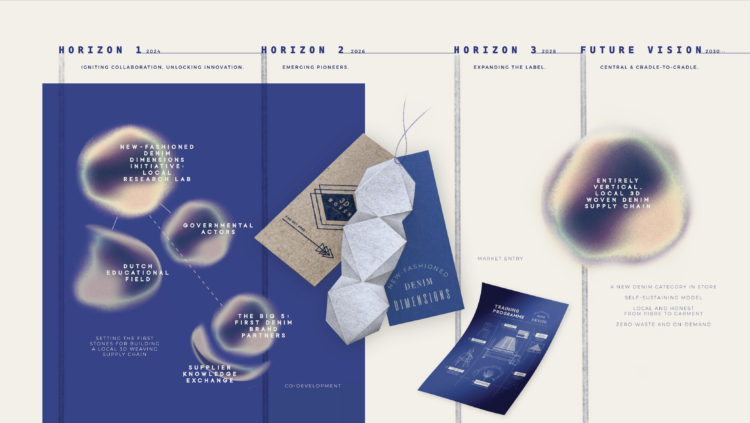A systems-oriented strategy to unlock the potential of 3D woven denim
Sterre de Jager proposed systemic changes in the textile system – one of the most impactful and unethical industries across the globe, in desperate need of cleaner practices and social justice.
Today’s fashion industry is characterised by a continuous cycle of rapid production, early disposal, low-quality materials, and pre-and post-consumer waste, with consequential environmental damage and social injustice. The production of denim involves a resource-intensive and lengthy supply chain, in which a lack of evolution in design over the past 150 years is coupled with significant pre-consumer waste. This highlights the need to reevaluate the design and manufacturing process. Conventional pattern designs result in a significant portion of newly woven material, sent to incineration and landfill.
3D weaving presents an innovative niche design-manufacturing technique, allowing for the creation of multi-layered structures with interwoven ‘seams’. This enables the production of nearly complete garments, while aiming for zero waste and reducing labour-intensive steps at the cut-and-sew stage. How can this new technique of 3D weaving garments be used to achieve systemic change within the Dutch denim market?
To tackle that question in her graduation thesis, Sterre fully immersed herself in the denim industry and came up with a holistic strategy towards systemic change.
The research was initiated by analysing the complex denim supply chain, addressing challenges in transparency, traceability and environmental concerns, as well as understanding the meaning of textiles. Field research at a denim mill in Pakistan formed the basis of a general ecosystem map, addressing various layers of the system from the final lens of the Dutch denim market. This includes material flow, fashion brands, consumers, post-disposal stage, government influence, and certifications. Further collaboration with 3D weaving experts, denim mills, designers, and user research supported the multifaceted approach.

Photos of several of the fieldtrips Sterre made.
Asking Sterre about the various fieldtrips, she explains the following:
When connecting to several relevant stakeholders in the denim industry, I quickly found out that the denim community isn’t all that big, which is ironic for a staple piece as widespread and established as denim. Everyone knows each other and the global community is very collaborative (apart from brands). This first became clear at the global denim trade show Kingpins, by chance hosted in Amsterdam, leading to many opportunities to further visit the context and conduct the research. For instance, I went to London, where I spent time with denim consultants at the ASOS headquarters, a denim designer and historian, local denim mill Blackhorse Lane Atelier and even a 3D weaving expert. I was amazed at how many people I was able to interview in such a short amount of time, but also how challenging it was to communicate the systemic lens and research aim to designers in a particularly stagnant form of design, as the process of designing denim has hardly changed over the last 150 years.
However, the most interesting fieldtrip must be my visit to Lahore, Pakistan. Diamond Denim by Sapphire, a big denim mill, was incredibly kind to fly me over. They not only helped me in weaving new trials of 3D woven denim items for conducting user research, but also showed me their entire supply chain: from spinning yarn to the construction and finishing of the garments. They gave me the opportunity to interview every head of department, while being extremely transparent in their efforts and bottlenecks toward sustainable manufacturing, leading to the result of a detailed, average denim supply chain map. Moreover, co-creative sessions took place with multiple groups of designers, managers, and department heads, to have the most grounded approach in designing the final strategy. Here, I learned that transformative action must be industry-led, but mainly from the perspective of brands – not manufacturers. Another additional valuable learning experience overall was to fully immerse myself other contexts for the first time and gain a cross-cultural understanding. Truly an experience of immense value.

Simplified version of the Systems-Oriented strategy and implementation roadmap.
The project concludes with a Systems-Oriented strategy to establish a local Dutch eco-label for 3D woven denim, alongside traditional denim: New-Fashioned Denim Dimensions. By involving relevant stakeholders in the denim system, including major brands and suppliers, an initiative structure and implementation roadmap were developed. The roadmap outlines key actions, such as refining zero-waste patterns, developing equipment and creating a training programme, necessary to establish local, vertical 3D weaving supply chain behind the label. The aim is to create a catalytic effect, inspiring denim brands to further explore future transitions towards local and sustainable models in the broader fashion industry, extending beyond the realm of 3D weaving.
Sterre affirms that her efforts on this endeavour do not end here. She aspires to keep contributing to a cleaner and more ethical fashion industry for our generations to come.
Curious to see the result? The thesis can be found here.
This October, a small piece of the work will be viewed at the Dutch Design Week 4TU exhibition in the sample gallery, with an article in the e-magazine.

